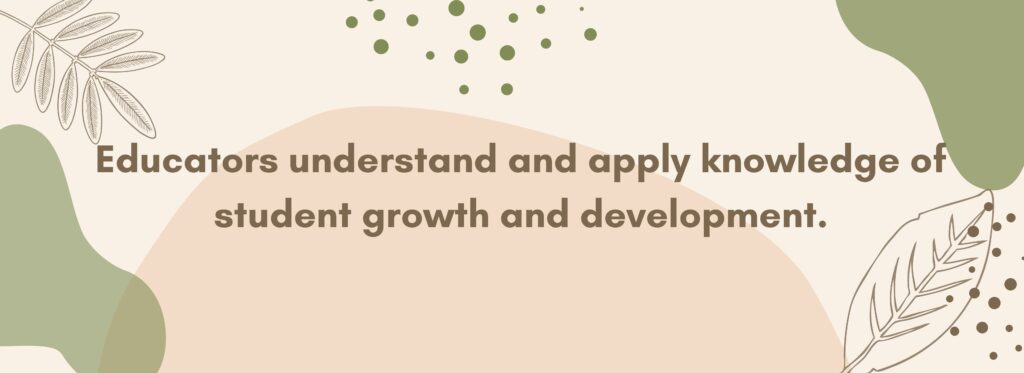
The Value of Growth Mindset
Throughout the program I have learned the importance of understanding and applying knowledge of student growth and development throughout my teaching practice. To me, it’s important to approach teaching with an awareness and understanding of the developmental stages of students growth. By having a strong understanding of students growth, I can implement teaching practices to meet individuals learning differences and needs. In support students development, I believe that Carol Dweck’s growth mindset can benefit all students. The concept of “growth mindset” means that we understand our capacity to learn and grow (Hutchinson & Specht, 2020, p. 59). When students haven’t accomplished something “yet” we can teach them that they need to focus on the “yet” and engage with the challenge so they can grow (Hutchinson & Specht, 2020, p. 59). I’ve learned that students and teachers with a growth mindset believe that their abilities can be developed and improved over time with practice. I’ve adopted the growth mindset language into my teaching practice, as I’ve discovered that by reframing our language to focus on the idea that a student has not learned “yet” but can learn and that making mistakes is part of life can positively affect students mindset. Additionally, I’ve learned the importance of modelling positive self-talk can support students development in a variety of subject areas and grade levels.
Hutchinson, N. L., & Specht, J. A. (2020). Inclusion of Learners with Exceptionalities in Canadian Schools Sixth Edition. North York, Ontario: Pearson Canada Inc. pg. 59.
When you’re in a growth mindset, what that means is you choose to see struggle and challenge as an opportunity for growth and for learning and development.
chris bertram
Different Learning Styles
To understand and apply knowledge of students growth and development, it is important to have a good understanding of how students learn. Applying Howard Gardner’s theory of Multiple Intelligences is a valuable tool in understanding how students best learn to support their growth and development (Bates, 2019, p. 84). Gardner proposed that human beings have several types of intelligences that form the potential to process information in a rename of different contexts. This theory suggests that the multiple intelligences includes account for the full range of human cognition, and that each student has a unique blend of the various intelligences (Bates, 2019, p. 84). By understanding the different intelligences, educators can identify the individual differences amongst their students to help them better understand their learning process and be more prepared to meet their learning needs (Bates, 2019, p. 84). Teachers can apply this theory in their classroom by allowing students the opportunity to approach learning activities in different ways (Bates, 2019, p. 84). I’ve also learned the importance of being aware that individuals have different strengths and will react differently according to the nature of the tasks set. Therefore, it is essential to get to know your students and form relationships as the foundation of the classroom environment, to support the planning and implementation of learning tasks that will be best suited for the students individual growth and development.
Bates, B. (2019). Learning Theories Simplified Second Edition. London : SAGE Publications Ltd. pg. 84
Scaffolding Learning & the Zone of Proximal Development
Another important theory of learning I believe supports students growth and development, is the theory of “scaffolding and the zone of proximal development” introduced by Lev Vygotsky (Bates, 2019, p. 48). This theory suggests that the process of learning through social interaction is the Zone of Proximal Development, and when learners are in this zone, they developed an understanding of a subject that may have been beyond their previous level of comprehension (Bates, 2019, p. 48). Additionally, the theory of scaffolding includes the following principles:
- Building interest in the subject area and engage with people.
- Break the given task into smaller sub-tasks.
- Keep the individual or group focused on completed the sub-tasks but reinforce the idea of the main task.
- Model possible ways of complete the task which individuals can imitate then eventual internalize.
Bates, B. (2019). Learning Theories Simplified Second Edition. London : SAGE Publications Ltd. pg. 48
In my practicum experiences, I have found applying these theories to be valuable way of understanding and supporting my students growth and development. It is important to understand students individual learning styles and needs prior to implementing lesson plans and tasks. Additionally, it is important to be aware of where students are at in their development to meet them where they are, and then to scaffold their learning in a way that they are able to process. Implementing this scaffolding of instruction through a classroom environment that includes a growth mindset can provide students with positive encouragement throughout their learning journey 🙂
